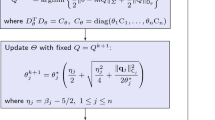Abstract
Software for studying the spatial structure of various complex systems based on the data of multichannel measurements is developed. Experimental space-time functions without information loss are converted into a functional tomogram: the set of independent oscillations. Each oscillation is generated by one dipole source and has a unique set of characteristics, including frequency, energy, and spatial parameters. It is also possible to select and represent spatial structures obtained by solving the inverse problem with the given accuracy. Using the data of magnetic encephalography (MEG) as an example, various options for filtering and displaying a functional tomogram of the human head are considered. The FTViewer application allows us to study in detail the work of the brain and the nature of noise signals.





Similar content being viewed by others
REFERENCES
J. Sarvas, “Basic mathematical and electromagnetic concepts of the biomagnetic inverse problem,” Phys. Med. Biol. 32 (1), 11–22 (1987). https://doi.org/10.1088/0031-9155/32/1/004
J. C. Mosher, P. S. Lewis, and R. M. Leahy, “Multiple dipole modeling and localization from spatio-temporal MEG data,” IEEE Trans. Biomed. Eng. 39 (6), 541–557 (1992). https://doi.org/10.1109/10.141192
Uutela, K., Hamalainen, M., and Salmelin, R., “Global optimization in the localization of neuromagnetic sources,” IEEE Trans. Biomed. Eng. 45 (6), 716–723 (1998). https://doi.org/10.1109/10.678606
J. A. Nelder and R. Mead, “A simplex method for function minimization,” Comput. J. 7 (4), 308–313 (1965). https://doi.org/10.1093/comjnl/7.4.308
J. Onton, M. Westerfield, J. Townsend, and S. Makeig, “Imaging human EEG dynamics using independent component analysis,” Neurosci. Biobehav. Rev. 30 (6), 808–822 (2006). https://doi.org/10.1016/j.neubiorev.2006.06.007
F. L. Foresta, N. Mammone, and F. C. Morabito, “PCA-ICA for automatic identification of critical events in continuous coma-EEG monitoring,” Biomed. Signal Process. Control 4, 229–235 (2009).
V. Litvak, A. Eusebio, A. Jha, et al., “Optimized beamforming for simultaneous MEG and intracranial local field potential recordings in deep brain stimulation patients,” Neuroimage 50 (4), 1578–1588 (2010). https://doi.org/10.1016/j.neuroimage.2009.12.115
R. D. Pascual-Marqui, “Standardized low-resolution brain electromagnetic tomography (sLORETA): Technical details,” Methods Find. Exp. Clin. Pharm. 24 (D), 5–12 (2002).
R. Oostenveld, P. Fries, E. Maris, and J. M. Schoffelen, “FieldTrip: Open source software for advanced analysis of MEG, EEG, and invasive electrophysiological data,” Comput. Intell. Neurosci. 2011, 156869 (2011). https://doi.org/10.1155/2011/156869
A. Stolk, A. Todorovic, J. M. Schoffelen, and R. Oostenveld, “Online and offline tools for head movement compensation in MEG,” Neuroimage 68, 39–48 (2013). https://doi.org/10.1016/j.neuroimage.2012.11.047
P. E. Aguera, K. Jerbi, A. Caclin, and O. Bertrand, “ELAN: A software package for analysis and visualization of MEG, EEG, and LFP signals,” Comput. Intell. Neurosci. 2011, 158970 (2011). https://doi.org/10.1155/2011/158970
F. Tadel, S. Baillet, J. C. Mosher, D. Pantazis, and R. M. Leahy, “Brainstorm: A user-friendly application for MEG/EEG analysis,” Comput. Intell. Neurosci. 2011, 879716 (2011). https://doi.org/10.1155/2011/879716
R. R. Llinás and M. N. Ustinin, “Frequency-pattern functional tomography of magnetoencephalography data allows new approach to the study of human brain organization,” Front. Neural Circuits 8, 43 (2014). https://doi.org/10.3389/fncir.2014.00043
R. R. Llinás, M. N. Ustinin, S. D. Rykunov, A. I. Boyko, V. V. Sychev, K. D. Walton, G. M. Rabello, and Garcia, J., “Reconstruction of human brain spontaneous activity based on frequency-pattern analysis of magnetoencephalography data,” Front. Neurosci. 9, 373 (2015). https://doi.org/10.3389/fnins.2015.00373
M. Frigo and S. G. Johnson, “The design and implementation of FFTW3,” Proc. IEEE 93 (2), 216–231 (2005). https://doi.org/10.1109/JPROC.2004.840301
A. Belouchrani, K. Abed-Meraim, J.-F. Cardoso, and E. Moulines, “A blind source separation technique using second-order statistics,” IEEE Trans. Signal Process. 45, 434–444 (1997). https://doi.org/10.1109/78.554307
J. Sarvas, “Basic mathematical and electromagnetic concepts of the biomagnetic inverseproblem,” Phys. Med. Biol. 32, 11–22 (1987). https://doi.org/10.1088/0031-9155/32/1/004
S. van der Walt, S. C. Colbert, and G. Varoquaux, “The NumPy Array: A structure for efficient numerical computation,” Comput. Sci. Eng. 13 (2), 22–30 (2011). https://doi.org/10.1109/MCSE.2011.37
J. D. Hunter, “Matplotlib: A 2D graphics environment,” Comput. Sci. Eng. 9 (3), 90–95 (2007). https://doi.org/10.1109/MCSE.2007.55
P. Ramachandran and G. Varoquaux, “Mayavi: 3D visualization of scientific data,” Comput. Sci. Eng. 13 (2), 40–51 (2011). https://doi.org/10.1109/MCSE.2011.35
W. Schroeder, K. Martin, and B. Lorensen, The Visualization Toolkit, 4th ed. (Kitware, 2006).
G. Niso, C. Rogers, J. T. Moreau, L. Y. Chen, C. Madjar, S. Das, E. Bock, F. Tadel, A. Evans, P. Jolicoeur, and S. Baillet, “OMEGA: The Open MEG Archive,” Neuroimage 124, 1182–1187 (2015). https://doi.org/10.1016/j.neuroimage.2015.04.028
Funding
The study was supported by the Russian Science Foundation (project no. 18-11-00178).
Author information
Authors and Affiliations
Corresponding authors
Ethics declarations
The authors declare that they have no conflict of interest.
Additional information

Stanislav Dmitrievich Rykunov. Born1986. Graduated from Moscow State University of Instrument Engineering and Informatics in 2012 and defended his candidate’s dissertation in 2016. Senior Researcher at the Institute of Mathematical Problems of Biology, Russian Academy of Sciences. Scientific interests: MEG, data processing and analysis, parallel computing. Author of over 40 papers.

Ekaterina Sergeevna Oplachko. Born 1988. Graduated from Voronezh State University in 2011. Researcher at the Institute of Mathematical Problems of Biology, Russian Academy of Sciences. Scientific interests: cloud technologies and encephalography data analysis. Author of 13 papers.

Mikhail Nikolaevich Ustinin. Born: 1957. Graduated from Moscow State University in 1981, defended his candidate’s dissertation in 1990 and his doctoral dissertation in 2004. Deputy director at Keldysh Institute of Applied Mathematics and head of the branch. Scientific interests: the creation of intelligent methods for data analysis and their application in biology and medicine. The author of over 170 papers, including two monographs. Member of the International Society for Neuroscience.
Rights and permissions
About this article
Cite this article
Rykunov, S.D., Oplachko, E.S. & Ustinin, M.N. FTViewer Application for Analysis and Visualization of Functional Tomograms of Complex Systems. Pattern Recognit. Image Anal. 30, 716–725 (2020). https://doi.org/10.1134/S1054661820040227
Received:
Revised:
Accepted:
Published:
Issue Date:
DOI: https://doi.org/10.1134/S1054661820040227




